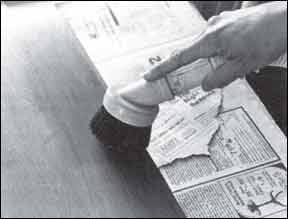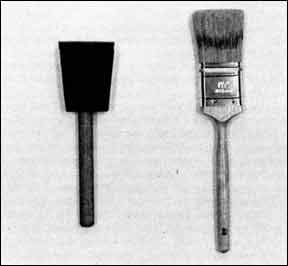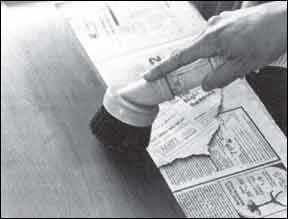It takes practice to produce a perfect, mirror finish on varnished wood, but it is not so much a difficult task as an exacting one, where attention to detail and no short cuts are the secrets to success.

288
Whether you are finishing new wood, refinishing old wood, or maintaining a finish in good condition, the basics are the same. Tools and materials required are sandpaper, vacuum cleaner or dusting brush, tack rag, brushes, and of course varnish and thinner If you are working from bare wood you may require stain or filler or a combination filler-stain. In cases where old wood has become discolored you will probably want to use a bleaching agent.
Be sure to have plenty of sandpaper in grits ranging from 120 to 220. Buy it by the sleeve if you are doing a job of any size at all, so that you are not tempted to scrimp. When the sandpaper fills up, get a new piece. It’s a small luxury to help make a rather boring process move more quickly.
Use a vacuum cleaner to clean up the sanding dust. It is truly the only way that all dust can be removed from tiny cracks and crevices. If you cannot use a vacuum cleaner for some reason, sweep the worst of the dust away with a brush. In either case, use a tack rag immediately before brushing on the varnish. It makes the difference between perfection and a lot of tiny dust grains in the final product.
A purchased tack rag is inexpensive and handy. If you don’t have one and can’t get one when you need it, you can make your own tack rag by dampening a yard square piece of old undershirt or other soft cotton with whatever solvent (thinner) your varnish calls for. Then trickle on a little varnish and wring out so the varnish and thinner get mixed. Fold the rag into a small square. In use, as you wipe off the sanding dust, you keep refolding the cloth to keep a cleanish surface on the work. When the whole rag is so dirty it won’t pick up any more dust, throw it away and tear out a new one. It’s a good idea to wear gloves, to prevent sticky hands.
When it comes to varnishes, you have a wide choice. Our own preference for exterior work is — probably because we’ve used it long enough to know it — conventional, bakelite spar varnish with a U V (ultraviolet) filter. Belowdecks we use both conventional and polyurethane varnishes with a slight preference for conventional coatings. In every case, read the directions and use the specified compatible thinners and cleaners.
Brushes must be either the cheapest type — polyfoam disposable brushes which are discarded after each use — or the best of the line — high quality bristle. There is no middle ground if you want a first class varnish job. We have had good results with both types of brush; the relevant variable is to use a brush which is perfectly clean and pliable.
Good bristle brushes are expensive, but properly cared for will last for years. You should drill a hole in your brushes just above the metal bristle holder. The hole is to allow you to insert a length of wire long enough to span a “keeper can.” A keeper can is a can filled with a solution of 75 % varnish or raw linseed oil and 25 % thinner Between coats you suspend the brush on its wire in the solution. This way you don’t have to clean the brush after every coat. Make sure the bristles are totally immersed but clear of the bottom of the can. Cover the can and brush with a rag. When ready to apply a new coat, wipe the brush well on clean rags and your in business. For long term liquid storage, the can must be tightly covered.
And here’s why we generally prefer conventional to polyurethane varnishes. It’s been our experience that brushes kept in a keeper can filled with a solution of polyurethane varnish and thinner develop tiny little scummies which mess up the new work and which only a complete cleaning will remove. A complete cleaning takes about fifteen minutes, uses up a lot of thinner, and in general is a pain. Here’s how to do it.

288
First, wipe the brush out well on rags, then saturate the brush with thinner, squeeze out, and wipe on a clean rag. Repeat four or five times until only a tiny bit of varnish is still in the brush. Then wash the brush thoroughly in soap and warm (not hot) water until all suspicion of varnish has been removed. Next, spin the water out of the brush by revolving it between the palms and fingers of both hands. Lay the brush — which will look like a feather duster after its spinning — on a dry newspaper covered surface. Let the brush almost dry before wrapping it in a flat envelope of newspaper. The newspaper wrap will reshape the brush and keep it clean until the next time you want to use it.
Start with a Good Surface
Surface preparation, like every other step in varnishing, is essential to a good result. New wood must be fair and sanded smooth with 120 grit paper. All cracks, joints and gaps must be filled with an appropriate compound.
If the wood is weathered and blackened to the point where normal sanding won’t remove the blackened spots, bleaching is called for. The traditional bleach is an oxalic acid solution made by dissolving 1/2 cup of oxalic acid crystals in one quart of hot water. Shake until the crystals are completely dissolved. Make and store the solution in a glass jar. Lable it “Bleach -Poison” and treat it as such.
Also make up a borax solution consisting of one cup of borax dissolved in one quart of hot water.
The oxalic acid solution is wiped on the bare, varnish-free, blackened or discolored spots. Go lighter with the solution toward the outer edges of the discoloration so that it will blend with the untreated areas. When the discoloration has disappeared, neutralize the bleach by swabbing on the borax solution. Allow to dry for 10 to 12 hours before sanding. That’s the traditional method.
But many years ago, an old boat yard finisher took pity on an earnest kid and suggested using common, liquid, houshold bleach . . you know, like you wash clothes with. We’ve used it ever since. It works a bit more slowly than oxalic acid and may require multiple applications, but that’s all to the good because it allows you to control the bleaching action. Neutralizing is done by flooding the surface with plain old water.
After any bleaching operation, you’re apt to find a slightly whitened surface when the wood has dried. Don’t worry, it sands off easily.
Besides sanding and bleaching, teak requires degreasing with a solvent type cleaner any number of which are commercially available.
At this point, with your bare wood bleached and sanded, you need to make a decision on whether to use a stain or filler. Most people today use these products because they easily supply a smooth finish with an even color. Their only disadvantages are -to some people’s taste a slightly too even, ie, artificial look, and a very slightly greater tendency to “lift” than has a “pure” varnish system.
If the wood you are finishing is fairly dense, you may select a low-viscosity stain which does not fill the wood. An open-grain wood, such as oak or mahogany, benefits from the use of a filler. The filler may stain the wood or may simply fill the grain with a natural or matched compound without coloring the surrounding wood.
Paste fillers and stains usually come as a very thick paste which needs to be thinned with the appropriate solvent which will be specified in the directions. The thinned coating is then painted on, and let stand for 10 or 15 minutes until the filler turns dull. Then using a clean rag, old towel, or burlap, you rub it off across the grain. Don’t be afraid to rub hard. The object is to rub off everything that hasn’t penetrated into the grain. If you don’t rub hard, you’ll end up with a blotchy finish which will look like brown paint under the varnish. From this it follows that you shouldn’t apply filler to an area greater than you can rub down before the filler sets like paint.
Whether you use stain or filler or nothing, the first coat of varnish should be thinned by at least 25 % to almost water consistency. This will seal the wood, but also raise the grain. Sand lightly with 180 or 220 grit to smooth the surface, but be careful to avoid cutting into the varnish. Subsequent coats are applied without extra thinning.

288
The advantages of varnish on bare wood are that it tends to be slightly less prone to lift and it possesses a certain honesty; ie, the grain shows clear and unsullied. A potential disadvantage is that uneven coloration in the wood shows through the varnish clearly, but we rather like that effect. A more serious drawback is the extra coats of varnish needed to get a smooth final coat on unfilled wood.
Many expert varnishers use varnish cups which you can make by soldering a “strike wire” across one side of the top of a tin cup or can. The strike wire allows you to wipe your brush each time you dip or charge it, yet avoid varnish dripping down the side of the cup. Since varnish cups have to be cleaned, we tend to forego the pleasures of a strike wire for the disposable joys of clean, empty tuna cans or margarine tubs.
Belowdecks, many people prefer non-gloss varnishes. There are two ways to achieve such finishes. The first is to use satin-finish varnish; the second is to hand rub.
Satin-finish varnish is the much easier method and looks almost as good as hand rubbed work -from five feet away you can’t tell the difference. Satin-finish varnish is used exactly as any other, with this one exception: Satin-finish varnish is the only varnish which should be stirred. Stirring gloss varnishes introduces air bubbles. Stirring satin-finish varnishes is necessary to mix in the deglossing agents. Stir such varnish gently until an even color throughout is achieved.
The traditional method of achieving a hand rubbed finish is to first rub down the final coat with powdered pumice applied with rubbing felt and water. This is then followed by a rubbing with rottenstone and crude oil applied with a soft cotton cloth.
Slightly easier are some modern rubbing compounds available at your local hardware store. We’ve used Duffy’s Elbow Grease with good results. This is a Vaseline like grease which is used with 0000 bronze wool. (The instructions call for steel wool, but tiny bits of steel wool inevitably end up rusting in a marine environment.)
Whether using pumice and rottenstone or one of the newer greases, the object of hand rubbing is to rub out all the dust sediment, brush strokes, rough spots, and hairs. It’s beautiful but lots of work. Try it on a small piece like a binocular or sextant box before deciding to hand rub the entire interior!
Finishing Touches
If you are lucky enough to be merely recoating a good finish, the trick lies in touching up the nicks and dings invisibly. They must be cleaned with thinner, and ever-solightly sanded, but not so that any color of new wood is exposed. Then touch up those spots with a few coats of varnish to bring them up to the level of the surrounding finish.
When the touching up is dry, thoroughly sand the entire finish with 180 grit paper, taking care to avoid breaking through the finish to the wood. Vacuum up the dust, tack with your tack rag, and apply the new coat.
When recoating, you should usually plan on two coats to maintain the finish. One coat is really insufficient to protect the finish for any length of time.
Always sand thoroughly between coats with 180 or 220 grit. Vacuum thoroughly and use the tack rag before brushing.
Finally, one of the most difficult aspects of on-board varnishing is getting the right weather conditions. Even slight dampness will compromise adhesion; blowing dust messes up your work; and hot sun can so heat the wood that the varnish won’t flow properly. Hence, you need clear, dry, calm, and warm but not hot weather (60′ to 80 is ideal) for proper varnishing.
Good luck with the weather and happy varnishing.
-J. Pazereskis



































